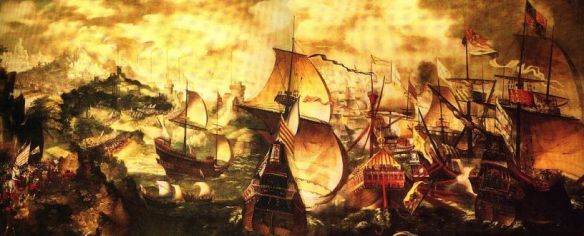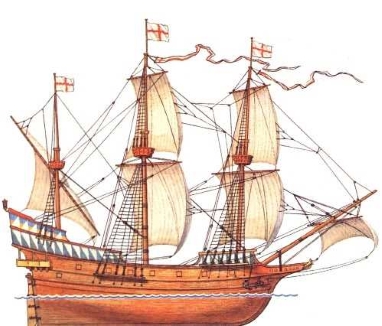"VOYAGE OF REPRISAL," by Kevin J. Glynn
Topic: Historical backdrop
The setting of this nautical fiction novel is 16th century England, the North Atlantic and islands therein, the Caribbean and Windward Islands, the South Atlantic, and the South American littoral. Although most of the story takes place outside of Europe, the characters bring their culture with them and are animated by political, religious, and economic factors long in forming and influenced by events in Western Europe. An understanding of the historical backdrop of Western Europe up to 1585 will help the reader better appreciate the story’s setting.

The Battle of Gravelines: public domain
England is ruled by the last of the Tudor line, the unmarried Queen Elizabeth I. Like her father, Henry VIII, Elizabeth strives to maintain England as an independent Protestant state, although a sizable Catholic minority remains. Ever since Luther, Calvin and Zwingli shaped the Protestant movement earlier in the century, Europe has been divided into two opposing ideological camps with little room for compromise. The imperial Roman Catholic Church, once all-powerful, has lost political and religious control over most of Northern Europe. Pope Sixtus V continues the efforts of his predecessors to mount a counter-reformation aimed at regaining temporal control over these renegade States and stamping out the ‘heresy’ of the Protestant movement. For this purpose, clandestine Jesuits are employed to infiltrate enemy territory and rally the faithful remaining behind. A ‘Holy League’ of powerful Catholic monarchs, lead by King Philip II of Spain, tries to coordinate and focus their efforts (monetary, clandestine and military) against the problem.
Compounding the religious dimensions, Northern European states (which happen to be Protestant) also face the imperial designs of an almost overwhelmingly strong Spain. Philip II inherited from his father, the Habsburg Holy Roman Emperor Charles V, the thrones of Spain, France-Comte, the Lowlands (modern-day Netherlands and Belgium) and Portugal (annexed in 1580). The Spanish army is considered the finest in the world. The Spanish Square, or tercio, consists of dense ranks of superbly drilled pikemen backed up by arquebus (early firearm) wielding men on the flanks and armored cavalry. The tercio is considered practically unstoppable. Backed up by an enormous wealth in gold and silver bullion from her American possessions, Spain stands ready to crush the freedoms of the Protestant Dutch and stamp out that last bastion of Protestant power in Western Europe - England.
England at this time controls only half of Great Britain. Scotland is independent and unfriendly. Ireland is nominally controlled but ever ready to rebel from Tudor rule. The loss of her former French possessions has left England, and her small population of about 3 million, almost marginalized as a nation. Her assets are her seamen, her fighting ships, and her trade items of broadcloth and tin. She needs markets for these commodities and must fight for the right to trade in an increasingly hostile world.
Philip II had England in his grasp earlier in the century when he married Henry VIII’s daughter, Mary (Bloody Mary) Tudor, who was Catholic. She was Queen of England for a few short years, during which time she tried to bring England back into the Catholic fold. She allied herself with Spain against Spain’s traditional enemy, France. Mary’s policies back-fired: France conquered England’s last remaining port towns on the French coast and, despite her persecutions, English Protestantism endured. After her death and a short interim under an adolescent King who died young, Elizabeth assumed the throne in 1558.
Philip II proposes marriage to Elizabeth, as do many other European ruling families, to draw the young queen into his political fold. Elizabeth plays them off each other to bide time, while building up a secret intelligence agency and a powerful navy. Ever short on cash, Elizabeth begins discreetly financing "armed trading ventures" and out-right piratical forays against Spain’s rich and poorly defended possessions in the Americas. When it finally becomes clear that Elizabeth is a dyed-in-the-wool Protestant providing aid and comfort to the rebellious Netherlanders, Pope Sixtus excommunicates her and Philip plots ways to have her assassinated and replaced with a Catholic claimant to the English throne - Mary Queen of Scots.
A cloak and dagger war ensues; Jesuit agents, renegade English Catholics and Spanish spies collude in plots to kill Elizabeth. English counter-spies uncover and foil the plots one by one. Mary Stuart, Queen of Scots, is captured in England and imprisoned. English ships begin engaging in a pseudo-war at sea with the Spanish in the Americas. Elizabeth dispatches small armies to the Netherlands while foiling Spanish efforts to do the same in Ireland. Events reach a head in 1585 when Spain formally declares war on England. Philip prepares an Armada to escort the ingenious and ruthless Prince of Parma from the Netherlands to the Thames to crush England once and for all. Elizabeth’s only defense is her renown English galleons and her “sea dog” ship captains.
Elizabeth’s sea dogs mount expeditions against Spanish coastal towns and shipping. Some of them are mere piratical expeditions; others spoiling attacks. England fearfully awaits the inevitable assault by a mighty Spanish Armada ferrying the Duke of Parma’s invincible army across the Strait of Dover. The fate of Protestantism and England’s independent future hangs in the balance.
Posted by Kevin J. Glynn
at 4:11 PM EDT
Updated: Monday, 22 August 2022 4:23 PM EDT




